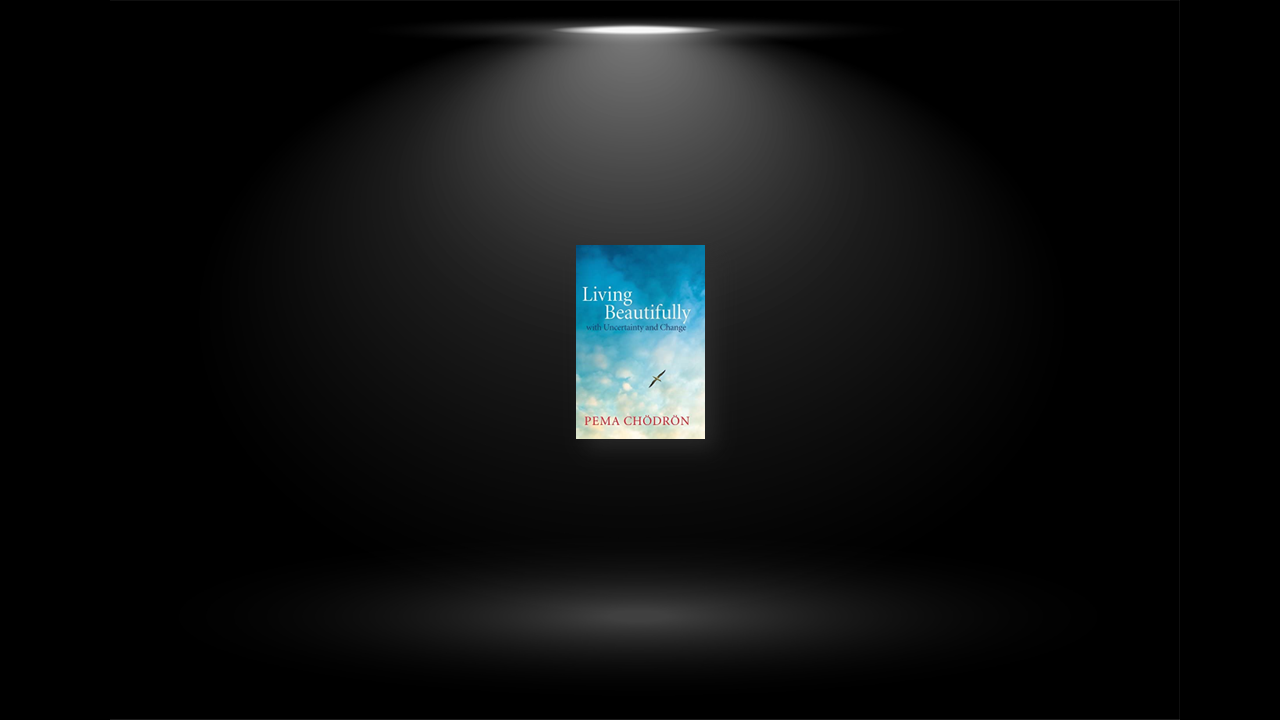Life without the Story Line
Buddhism holds that the true nature of the mind is as vast as the sky and that thoughts and emotions are like clouds that, from our vantage point, obscure it. We’re taught that if we want to experience the boundlessness of the sky, we’ll need to get curious about those clouds. When we look deeply into the clouds, they fall apart, and there’s the expanse of sky. It never went anywhere. It has always been here, momentarily hidden from us by the fleeting, shifting clouds.
The journey of awakening takes discipline and courage. Letting go of our cloud-like thoughts and emotions is by no means habitual at first. The thoughts and emotions may make it difficult for us to contact the openness of our minds, but they’re like old friends who have accompanied us for as long as we can remember, and we’re very resistant to saying good-bye. But each time you begin to meditate, you can decide that you’re going to see if you can let the thoughts go and be right here with the immediacy of your experience. Perhaps you can be right here for only five seconds today, but any progress in the direction of nondistraction is positive.
All of our habitual patterns are efforts to maintain a predictable identity: “I am an angry person”; “I am a friendly person”; “I am a lowly worm.” We can work with these mental habits when they arise and stay with our experience not just when we’re meditating but also in daily life. Whether we’re alone or with others, no matter what we’re doing, uneasiness can float to the surface at any time. We may think those poignant, piercing feelings are signs of danger, but in fact, they’re signals that we’ve just contacted the fundamental fluidity of life.
Rather than hiding from these feelings by staying in the bubble of ego, we can let the truth of how things really are get through. These moments are great opportunities. Even if we’re surrounded by people—in a business meeting, say—when we feel uncertainty arising, we can just breathe and be present with the feelings. We don’t have to panic or withdraw into ourselves. There’s no need to respond habitually. No need to fight or flee. We can stay engaged with others and at the same time acknowledge what we’re feeling.
The Three Commitments are three levels of working with groundlessness. Underlying them all is the basic instruction to make friends with yourself—to be honest with yourself and kind. This begins with the willingness to stay present whenever you experience uneasiness. As these feelings arise, rather than running away, you lean into them. Instead of trying to get rid of thoughts and feelings, you become curious about them. As you become accustomed to experiencing sensation free of interpretation, you will come to understand that contacting the fundamental ambiguity of being human provides a precious opportunity—the opportunity to be with life just as it is, the opportunity to experience the freedom of life without a story line.
Commitment #1: Committing to Not Cause Harm
The first commitment is about refraining from speech and actions that are harmful to ourselves and others. It liberates us by making us far more aware of what we’re feeling, so that whenever the urge to lie or slander or take something that isn’t given to us comes up—whenever we have the urge to act out our desires or aggression, or escape in any form—we refrain.
As a support in refraining from harmful speech and actions, it can be really helpful to commit to four traditional precepts, or directives: the precepts to not kill, to not steal, to not lie, and to not harm others with our sexual activity. We can commit to these precepts for one day or one week or a lifetime. There are hundreds of rules for fully ordained monks and nuns, but the Buddha said that the most important were these four. Basically, following the precepts gives us space to examine every nuance of the urge to express ourselves negatively and then, while fully acknowledging our feelings, make the choice to not do anything that would cause harm.
In its simplest terms, then, the path of liberation begins with refraining from hurting ourselves and others. When many people hear “refrain,” they automatically think “repression” and assume that when an urge comes up, they should just push it under. In therapeutic circles, there’s an ongoing debate about which causes more harm: repression or acting out. To me, they’re equally harmful. Once you speak or act, there’s a chain reaction, and other people’s emotions become involved. Every time you speak or act out of aggression or craving or jealousy or envy or pride, it’s like dropping a pebble into a pool of water and watching the ripples fan out; everyone around you is affected. Similarly, if you repress your feelings, everyone is affected by that too, because you’re walking around like a keg of dynamite that’s about to go off.
Commitment #2: Committing to Take Care of One Another
COMPASSION IS THREATENING to the ego. We might think of it as something warm and soothing, but actually it’s very raw. When we set out to support other beings, when we go so far as to stand in their shoes, when we aspire to never close down to anyone, we quickly find ourselves in the uncomfortable territory of “life not on my terms.” The second commitment, traditionally known as the Bodhisattva Vow, or warrior vow, challenges us to dive into these noncozy waters and swim out beyond our comfort zone.
Our willingness to make the first commitment is our initial step toward relaxing completely with uncertainty and change. The commitment is to refrain from speech and action that would be harmful to ourselves and others and then to make friends with the underlying feelings that motivate us to do harm in the first place. The second commitment builds on this foundation: we vow to move consciously into the pain of the world in order to help alleviate it. It is, in essence, a vow to take care of one another, even if it sometimes means not liking how that feels.
The second commitment is connected deeply and unshakably with bodhicitta, traditionally defined as a longing to awaken so that we can help others do the same, a longing to go beyond the limits of conventional happiness, beyond enslavement to success and failure, praise and blame. Bodhicitta is also a trust in our innate ability to go beyond bias, beyond prejudice and fixed opinions, and open our hearts to everyone: those we like, those we don’t like, those we don’t even notice, those we may never meet. Bodhicitta counteracts our tendency to stay stuck in very narrow thinking. It counteracts our resistance to change.
This degree of openness arises from the trust that we all have basic goodness and that we can interact with one another in ways that bring that out. Instead of reacting aggressively when we’re provoked, endlessly perpetuating the cycle of pain, we trust that we can engage with others from a place of curiosity and caring and in that way contact their innate decency and wisdom.
Commitment #3: Committing to Embrace the World Just as It Is
WITH THE THIRD COMMITMENT, we step fully into groundlessness, relaxing into the continually changing nature of our situation and experiencing it as awakened energy, as the manifestation of basic goodness. In some sense, this is nothing new. It’s what we’ve been training in all along. But experientially it’s a big leap forward, and it points us toward a major shift in consciousness. We take what we’ve integrated from the previous commitments, particularly being fully present with an open heart, and up the ante. Here the emphasis is on fully, and the demand to put fully present into practice is far greater. This definitely squeezes the old self-absorbed habit of ego clinging considerably. The feeling of nowhere to hide can be quite intense.
The third commitment, traditionally known as the Samaya Vow, is a commitment to embrace the world just as it is. Samaya is a Tibetan word meaning “sacred vow” or “binding vow.” It entails a coming together with our total experience, an unshakable bond with life. With this commitment, we accept that we are bound to reality, bound to everything we perceive in every moment. There is no way to get away from our experience, nowhere to go other than right where we are. We surrender to life. We give in and settle down with all the sights, sounds, smells, tastes, thoughts, and people we encounter. This is a commitment to not reject anything. The words of the Tibetan Buddhist master Dilgo Khyentse express this beautifully: The everyday practice is simply to develop a complete acceptance and openness to all situations and emotions, and to all people, experiencing everything totally without mental reservations and blockages, so that one never withdraws or centralizes into oneself.
The attitude of the third commitment is that we live in a world that is intrinsically good, intrinsically awake, and our path is to realize this. Simply put, the practice at this stage is to turn toward your experience, all of it, and never turn away.
There are some verses by Chögyam Trungpa that describe what such a world is like. He begins by describing sight as a doorway to sacred world: Whatever is seen with the eyes is vividly unreal in emptiness, yet there is still form. “Vividly unreal in emptiness” refers to the ordinary, everyday world, empty of concept, free of labels, clearly perceived in all of its brilliance but never fully graspable. Then the verse goes on to say “yet there is still form.” Emptiness and form are forever inseparable. What we see—our perception of ordinary, no-big-deal sights—is the form, the manifestation of emptiness, of awakened energy. From the moment we wake up in the morning to the moment we fall asleep—and even in our dreams—there is continuous, ceaseless manifestation. We always have the opportunity to let our sight connect us with the preciousness of this sacred world.


